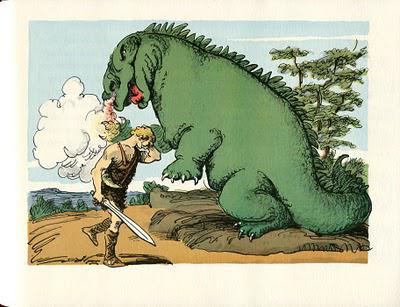 OUTSIDE OF HIS MAGAZINE WORK, it is hard to imagine John Updike as a hired writer. But his entry into children's literature was just that, as a hired writer. Through the 1960s, Updike wrote three adaptations for Warren Chappell's music series: The Magic Flute (1962), The Ring (1964), and Bottom's Dream (1969). All of the books follow the same form as Chappell's other books in the series, which can be gleaned from the highly accurate credits. For example, Bottom's Dream adapted from William Shakespeare's A Midsummer Night's Dream by John Updike with music by Felix Mendelssohn and illustrations by Warren Chappell. In short, a synopsis of the source music's story with selections of staff music and Chappell illustrations throughout.
OUTSIDE OF HIS MAGAZINE WORK, it is hard to imagine John Updike as a hired writer. But his entry into children's literature was just that, as a hired writer. Through the 1960s, Updike wrote three adaptations for Warren Chappell's music series: The Magic Flute (1962), The Ring (1964), and Bottom's Dream (1969). All of the books follow the same form as Chappell's other books in the series, which can be gleaned from the highly accurate credits. For example, Bottom's Dream adapted from William Shakespeare's A Midsummer Night's Dream by John Updike with music by Felix Mendelssohn and illustrations by Warren Chappell. In short, a synopsis of the source music's story with selections of staff music and Chappell illustrations throughout.
So who just decides to "hire" John Updike to write the text for a children's book? To give you a sense of who Warren Chappell was, I quote from his autobiography:
"I had thought of The Magic Flute for a very long time but wondered about a writer who could tell the story in the mere three thousand words which were mandated by the format. The one person who seemed right was John Updike, and I inquired to find his editor at Knopf. It turned out to be Alfred himself who served as contact."
 In case you missed that, it was Alfred Knopf himself that made the introduction. At this point, Updike had published a book of poetry, a book of short stories, and only two novels. He was a rising star--that second novel was Rabbit, Run--but was still a relatively young and new talent. It was Chappell, illustrator, designer, author, typeface designer, who was the great master.
In case you missed that, it was Alfred Knopf himself that made the introduction. At this point, Updike had published a book of poetry, a book of short stories, and only two novels. He was a rising star--that second novel was Rabbit, Run--but was still a relatively young and new talent. It was Chappell, illustrator, designer, author, typeface designer, who was the great master. He continues:
"John agreed to the Mozart and then suggested The Ring. Finally, we did Bottom's Dream, the dream sequence from A Midsummer Night's Dream. It was a very satisfying collaboration, and that promise made by Bottom, the weaver, that he would get Peter Quince to write up his experience and it would be called Bottom's Dream, had finally come to pass."Chappell is best known now as a typeface designer and as the author of A Short History of the Printed Word (1970), but his work in books is so long and varied that it is hard to condense while still giving it the necessary weight. He worked on well over four hundred books published over fifty years including editions of Winnie the Pooh, Moby Dick, and Don Quixote, not to mention any additional works set in the types he designed, Lydian series, Trajanus series, and Koch Uncial (co-designed with Paul Koch). I will skim the surface of that career and talk more about the music series in a future post.

As for Updike's texts in the series, they serve their purpose. The prose is unmistakably Updike, but all of the weaknesses of the original stories are carried into the books, which makes for thin and confusing children's books.
The best of the books is undoubtedly The Ring. Even people without any knowledge of the Wagner opera can follow Updike's telling of the story, which reads like a children's version of Lord of the Rings.

"This is a story of greed and love, of giants, dwarfs, and gods. It happened long ago, in Germany, the land of the mighty river Rhine. Even to this day the river glitters as if with gold--but people say it is just the sun striking the water.
In those old days the gold was real."

In all three of the books, the amount of text and the complexity of the language make these suited for elementary school age children.

I have posted all of Chappell's color illustrations for The Magic Flute and The Ring on my Flickr page. I hope to post Bottom's Dream in full later this week to better show Chappell's overall design, and the way music is integrated into the text. The quotes and background material for this post come from Warren Chappell's autobiography in volume ten of Gale's journal Something About the Author (1990).
Coming Soon: Warren Chappell
All images are copyrighted © and owned by their respective holders.

